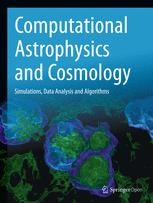CompAC: Entropy-limited hydrodynamics
 Guercilena F, Radice D, and Rezzolla L, Entropy-limited hydrodynamics: a novel approach to relativistic hydrodynamics, Comput. Astrophys. Cosmol. (2017) 4:3 doi:10.1186/s40668-017-0022-0
Guercilena F, Radice D, and Rezzolla L, Entropy-limited hydrodynamics: a novel approach to relativistic hydrodynamics, Comput. Astrophys. Cosmol. (2017) 4:3 doi:10.1186/s40668-017-0022-0
Research | Open Access
Published: 4 July 2017
Abstract:
We present entropy-limited hydrodynamics (ELH): a new approach for the computation of numerical fluxes arising in the discretization of hyperbolic equations in conservation form. ELH is based on the hybridisation of an unfiltered high-order scheme with the first-order Lax-Friedrichs method. The activation of the low-order part of the scheme is driven by a measure of the locally generated entropy inspired by the artificial-viscosity method proposed by Guermond et al. (J. Comput. Phys. 230(11):4248-4267, 2011, doi:10.1016/j.jcp.2010.11.043). Here, we present ELH in the context of high-order finite-differencing methods and of the equations of general-relativistic hydrodynamics. We study the performance of ELH in a series of classical astrophysical tests in general relativity involving isolated, rotating and nonrotating neutron stars, and including a case of gravitational collapse to black hole. We present a detailed comparison of ELH with the fifth-order monotonicity preserving method MP5 (Suresh and Huynh in J. Comput. Phys. 136(1):83-99, 1997, doi:10.1006/jcph.1997.5745), one of the most common high-order schemes currently employed in numerical-relativity simulations. We find that ELH achieves comparable and, in many of the cases studied here, better accuracy than more traditional methods at a fraction of the computational cost (up to ∼50% speedup). Given its accuracy and its simplicity of implementation, ELH is a promising framework for the development of new special- and general-relativistic hydrodynamics codes well adapted for massively parallel supercomputers.
